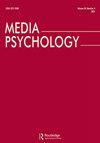Measuring Zoom Fatigue in College Students: Development and Validation of the Meeting Fatigue Scale for Videoconferencing (MFS-V) and the Meeting Fatigue Scale for In-Person (MFS-I)
IF 2.6
2区 心理学
Q1 COMMUNICATION
引用次数: 0
Abstract
The COVID-19 pandemic saw a significant growth in the usage of videoconferencing platforms such as Zoom in academia – accompanied by greater reports of exhaustion and burnout associated with extensive video meetings from college students. Given that videoconferencing adoption will likely persist, it is critical to develop a psychometrically sound tool for the measurement of "Zoom fatigue.” However, current measures for Zoom fatigue fail to control for similarities to in-person meeting fatigue. Thus, we designed and validated a scale to measure Zoom fatigue, the Meeting Fatigue Scale for Videoconferencing (MFS-V) along with a companion scale to measure in-person meeting fatigue, the Meeting Fatigue Scale for In-Person (MFS-I). Exploratory factor analyses (EFA) revealed that the MFS-V and MFS-I had different factor structures, and provided evidence that Zoom fatigue is a conceptually distinct phenomenon from in-person meeting fatigue. This finding was supported by confirmatory factor analyses (CFA) that supported the fit of both factor structures. Both scales demonstrated strong reliability, convergent validity, divergent validity, and incremental validity over measures of general burnout and meeting duration and frequency. These results suggest the MFS-V and MFS-I are effective tools for assessing and understanding fatigue and burnout related to videoconferencing and in-person meeting attendance for students. [ FROM AUTHOR] Copyright of Media Psychology is the property of Taylor & Francis Ltd and its content may not be copied or emailed to multiple sites or posted to a listserv without the copyright holder's express written permission. However, users may print, download, or email articles for individual use. This may be abridged. No warranty is given about the accuracy of the copy. Users should refer to the original published version of the material for the full . (Copyright applies to all s.)大学生变焦疲劳测量:视频会议会议疲劳量表(MFS-V)和面对面会议疲劳量表(MFS-I)的编制与验证
在2019冠状病毒病大流行期间,学术界对Zoom等视频会议平台的使用大幅增加,同时大学生报告称,与大量视频会议相关的疲劳和倦怠也越来越多。鉴于视频会议的采用可能会持续下去,开发一种心理计量学上可靠的工具来测量“缩放疲劳”是至关重要的。然而,目前针对Zoom疲劳的措施未能控制与面对面会议疲劳的相似性。因此,我们设计并验证了一个测量缩放疲劳的量表,即视频会议会议疲劳量表(MFS-V),以及一个测量面对面会议疲劳的配套量表,即面对面会议疲劳量表(MFS-I)。探索性因子分析(EFA)揭示了MFS-V和MFS-I具有不同的因子结构,并提供了证据,证明Zoom疲劳是一种概念上不同于面对面会议疲劳的现象。这一发现得到了验证性因素分析(CFA)的支持,该分析支持两种因素结构的拟合。两种量表的信度、收敛效度、发散效度和增量效度均高于一般倦怠和会议持续时间和频率。这些结果表明,MFS-V和MFS-I是评估和理解与视频会议和面对面会议出席相关的学生疲劳和倦怠的有效工具。媒体心理学的版权是Taylor & Francis Ltd的财产,未经版权所有者的明确书面许可,其内容不得复制或通过电子邮件发送到多个网站或发布到listserv。但是,用户可以打印、下载或通过电子邮件发送文章供个人使用。这可以删节。对副本的准确性不作任何保证。用户应参阅原始出版版本的材料的完整。(版权适用于所有人。)
本文章由计算机程序翻译,如有差异,请以英文原文为准。
求助全文
约1分钟内获得全文
求助全文
来源期刊

Media Psychology
Multiple-
CiteScore
8.60
自引率
7.10%
发文量
30
期刊介绍:
Media Psychology is an interdisciplinary journal devoted to publishing theoretically-oriented empirical research that is at the intersection of psychology and media communication. These topics include media uses, processes, and effects. Such research is already well represented in mainstream journals in psychology and communication, but its publication is dispersed across many sources. Therefore, scholars working on common issues and problems in various disciplines often cannot fully utilize the contributions of kindred spirits in cognate disciplines.
 求助内容:
求助内容: 应助结果提醒方式:
应助结果提醒方式:


